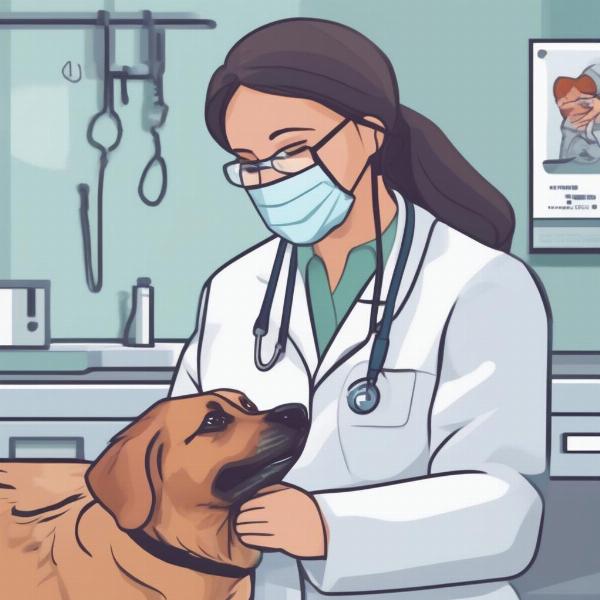Trilostane is a medication commonly prescribed for dogs with Cushing’s disease (hyperadrenocorticism). Understanding the correct trilostane dose for your dog is crucial for managing this condition effectively and ensuring your furry friend’s well-being. This guide provides a detailed overview of trilostane dosage, administration, monitoring, and potential side effects.
Understanding Trilostane and Cushing’s Disease
Cushing’s disease occurs when a dog’s adrenal glands produce excessive cortisol. This hormonal imbalance can lead to a variety of symptoms, including increased thirst and urination, increased appetite, panting, hair loss, and a pot-bellied appearance. Trilostane works by inhibiting the production of cortisol, helping to alleviate these symptoms and improve the dog’s quality of life. The appropriate trilostane dose varies depending on the individual dog’s weight, severity of the disease, and response to treatment.
Determining the Right Trilostane Dose for Dogs
Your veterinarian will determine the initial trilostane dose for your dog based on factors such as their weight and the severity of their Cushing’s disease. It’s important to follow your veterinarian’s instructions carefully and never adjust the dosage without their guidance. A common starting dose is around 1-3 mg per pound of body weight, given once or twice daily with food.
Monitoring and Adjustments
Regular monitoring is essential to ensure the effectiveness and safety of trilostane therapy. Your veterinarian will likely recommend blood tests, such as an ACTH stimulation test, to assess your dog’s cortisol levels and adjust the dosage accordingly. The goal is to find the lowest effective dose that controls the symptoms of Cushing’s disease while minimizing potential side effects. It’s crucial to be patient and consistent with the monitoring process, as finding the optimal dose can sometimes take time.
Administering Trilostane
Trilostane should always be given with food to enhance absorption and minimize the risk of gastrointestinal upset. If your dog vomits shortly after taking the medication, consult your veterinarian. They may recommend repeating the dose or adjusting the administration schedule.
Potential Side Effects of Trilostane in Dogs
While generally well-tolerated, trilostane can cause some side effects in dogs. Common side effects include vomiting, diarrhea, lethargy, and loss of appetite. In rare cases, more serious side effects such as Addisonian crisis (a sudden drop in cortisol levels) can occur. It’s important to contact your veterinarian immediately if you notice any unusual symptoms in your dog.
Recognizing Signs of Addisonian Crisis
Addisonian crisis is a serious condition that requires immediate veterinary attention. Signs of Addisonian crisis include weakness, vomiting, diarrhea, collapse, and shaking. If you suspect your dog is experiencing an Addisonian crisis, seek emergency veterinary care immediately.
 Veterinarian examining a dog
Veterinarian examining a dog
Conclusion
Trilostane can significantly improve the quality of life for dogs with Cushing’s disease. By working closely with your veterinarian, monitoring your dog’s response to treatment, and understanding the potential side effects, you can help ensure your furry companion receives the appropriate trilostane dose and enjoys a healthier, happier life.
FAQ
- How long does it take for trilostane to work in dogs? Trilostane typically starts working within a few days to weeks, but individual responses can vary.
- Can trilostane be given to cats? Trilostane is specifically formulated for dogs and should not be given to cats.
- What should I do if I miss a dose of trilostane? Give the missed dose as soon as you remember, unless it’s close to the time for the next dose. Do not double the dose.
- Can trilostane cure Cushing’s disease? Trilostane manages the symptoms of Cushing’s disease but does not cure the underlying condition.
- Are there any natural alternatives to trilostane? While some natural remedies may be suggested, it’s crucial to discuss any alternative treatments with your veterinarian before using them.
- What is the long-term prognosis for dogs with Cushing’s disease treated with trilostane? With proper management and monitoring, dogs with Cushing’s disease can live comfortably for many years.
- Can trilostane be used with other medications? Discuss all medications your dog is taking with your veterinarian to avoid potential drug interactions.
Related Articles
About ILM Dog: ILM Dog is your trusted resource for expert advice on dog care, offering guidance on everything from breed selection and health to training, nutrition, and grooming. We’re dedicated to helping dog owners worldwide provide the best possible care for their canine companions. For personalized advice or to learn more about our services, contact us via email at [email protected] or call us at +44 20-3965-8624.